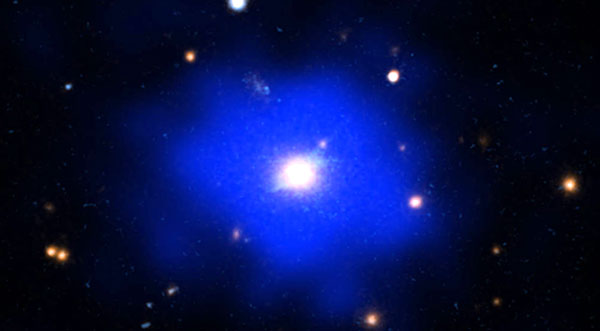NASA & SPACE NEWS

(NASA) – The discovery of the most distant galaxy cluster with a specific important trait as described in our press release is providing insight into how these gigantic structures formed and why the universe looks like it does in the present day.
This composite image shows SPT-CL J2215-3537 in X-rays from NASA’s Chandra X-ray Observatory (blue) and a combination of ultraviolet, optical, and infrared light from NASA’s Hubble Space Telescope.
Astronomers used Chandra to find this distant and unusually young galaxy cluster, along with NSF/DOE’s South Pole Telescope, the Dark Energy Survey project in Chile, and NASA’s Spitzer Observatory. The results have been reported in a series of three papers.
SPT2215 is located about 8.4 billion light-years from Earth. This means it is seen when the universe is only 5.3 billion years old, compared to its current age of 13.8 billion years.
While there have been many clusters seen at this large distance, SPT2215 possesses a quality that makes its whereabouts particularly intriguing. SPT is what astronomers refer to as “relaxed,” meaning that it shows no signs of having been disrupted by violent collisions with other clusters of galaxies.
Galaxy clusters – some of the biggest structures in the universe — grow over time by merging with other galaxy clusters or groups, causing disturbances such as asymmetries or sharp features in the cluster’s gas.
Given enough time to “relax,” however, the gas can take on a smooth, calm appearance, as seen with SPT2215. Until the identification of SPT2215, astronomers had not found a relaxed galaxy cluster this far away. In fact, scientists were not sure they would find a galaxy cluster that was relaxed at this epoch of the universe, because they are usually still undergoing the turmoil of mergers with other clusters or groups of galaxies as they increase in size.
Another interesting aspect of SPT2215 is the evidence for large amounts of star formation happening in its center. SPT2215 has a very large galaxy in its middle, which in turn has a supermassive black hole at its core.
The prodigious amount of star formation shows scientists that much of the hot has cooled to the point where new stars can form, without outbursts driven by the black hole providing a heating source that prevents most of this cooling.
This addresses an ongoing question of how much black holes stymie or support the birth of stars in their environments.
The central galaxy in SPT2215 is also quite isolated, with no other galaxies within about 600,000 light-years that are anywhere near as bright or extended.
This implies that the cluster has not experienced a merger with another cluster in about the last billion years, giving another piece of evidence that SPT2215 is relaxed.
The three papers on SPT2215, in reverse order of publication, were a recent paper led by Michael Calzadilla and his colleagues published in the April 20, 2023 issue of The Astrophysical Journal; a paper led by Adam Mantz published in the February 2022 issue of Monthly Notices of the Royal Astronomical Society (a preprint is available online) and a paper led by Lindsay Bleem et al. published in the March 2020 issue of The Astrophysical Journal Supplement Series.
NASA’s Marshall Space Flight Center manages the Chandra program. The Smithsonian Astrophysical Observatory’s Chandra X-ray Center controls science operations from Cambridge, Massachusetts, and flight operations from Burlington, Massachusetts.
CLICK HERE FOR BREVARD COUNTY NEWS
The post NASA’s Chandra X-Ray Observatory Discovers Galaxy Cluster 8.4 Billion Light-Years from Earth appeared first on Space Coast Daily.

